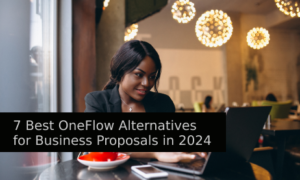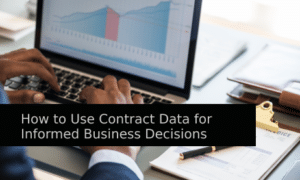Following up on business proposals can be daunting when you’re a digital marketer or work for a digital marketing agency.
You want to ensure that you are professional, courteous, and firm in your convictions. And if you don’t follow up correctly, you may lose the business to a competitor.
But don’t worry! Because in this blog post will discuss eight super-useful tips that will help you follow up on your business proposals effectively.
1. Start with a plan
The first step to effectively following up on your proposal is to have a plan. You should know who you need to contact, what information you need to include, and what you want to accomplish with the follow-up.
A follow-up isn’t always about “closing the deal.” Sometimes, you want to reinforce your company’s strengths and address any concerns the client may have to seal the deal effectively.
If you’re following up via email, you must also determine a schedule and frequency for your follow-up messages.
Research suggests that the best time to follow up with a client is within 24 hours of sending the proposal. After that, you can continue following up every few days until you hear back from the client.
In addition, make sure you’re sending enough follow-up emails. Data from a study conducted by Iko System suggests that you should send at least five follow-ups before giving up:

Source
To ensure you stick to the follow-up frequency you decide, schedule your emails using an email scheduling tool or find a proposal management platform with scheduling capabilities.
2. Separate warm and cold leads
If you’ve sent your proposal to multiple clients, then it might be a good idea to separate your follow-ups based on how warm or cold each lead is.
We’re not using the terms “warm” and “cold” in the traditional sense. Instead, a “warm lead” is a client that has opened (and forwarded) your business proposal email and a “cold lead” is a client that hasn’t.
You can use an email tracking tool to see which clients have opened your proposal email and which ones haven’t.
When you follow up with your warm leads, you can use a more personalized approach since you know they’re interested in your proposal.
On the other hand, when you follow up with cold leads, you’ll want to take a more general approach since you’re not sure if they’re interested.
If a cold lead doesn’t respond to your follow-up emails after a few attempts, you can assume they’re not interested and move on.
3. Offer something new in each follow-up message
If you’re following up with a client who has already expressed interest in your proposal, you want to ensure that each follow-up message contains something new.
This could be a new case study, additional information about your business proposal, a discount, or anything that makes your proposal stand out.
Offering something new in each follow-up increases the chances that the client will engage with your proposal.
Here is one example of a follow-up email showing additional information to the prospect:

4. Personalize, personalize, personalize
We can’t stress this enough: your follow-up messages must be personalized!
A personalized message shows that you care about the client and their needs. It also makes it more likely that the client will read and respond to your message.
To personalize your follow-up messages, you can use the client’s name, mention something you discussed in a previous meeting, or even reference their company’s latest news.
You can also use email enrichment — a service offered by some email finding tools — to find background information about an email address, such as associated social media accounts. You can then use this information to find additional attributes that can be used to personalize your follow-ups. Creating a digital business card can go a long way in personalizing your email. Share links to a gift voucher or a discount coupon along with contact details in the card and add it as your email signature
Remember, 75% of marketers think email personalization improves the click-through rate, so it’s something you don’t want to miss out on.

5. Try a multi-channel approach
Most business owners are busy people. So even if you’re sending them personalized follow-up messages, there’s a chance they might not see your email right away.
That’s why we recommend using a multi-channel approach to follow-ups. In addition to email, you can also use phone calls, LinkedIn messages, or even postcards.
By using multiple channels, you’re increasing the chances that your message will be seen and that you’ll be able to follow up with your client effectively.
Which channels you use will depend on the preferences of your client. So make sure to include this as one of the questions you ask before making a proposal.
If this information is not available, then email is usually the best option. But if you still want to use a multi-channel approach, you can use this infographic by GetApp to guide your choices:

Although this data is not precisely related to B2B marketing, it still gives you some idea about how people prefer to be contacted.
6. Be very clear with your call-to-action (CTA)
Everyone knows the importance of including a CTA in follow-up emails. But we often see that businesses will use a generic CTA such as “let’s meet” or “call me.”
While there’s nothing wrong with these CTAs, they’re not very specific and don’t tell the client what you want them to do.
A better approach is to use a specific CTA that tells the client exactly what you want them to do. For example, “schedule a meeting on Zoom” or “call me on Skype to discuss your project.”
You can also go one step further and propose a specific time or date for the meeting. This shows that you’re organized and value the client’s time. Plus, it removes the pressure on the client to come up with a time that works for both of you, reducing their cognitive load.
7. Don’t be pushy (with everyone)
When following up with clients, it’s essential to be persistent without being pushy. If a client is not interested in your proposal, then there’s no point in trying to sell them on it.
But at the same time, it’s important to remember that each client is different and that you should tailor your follow-up approach to their individual needs and preferences.
Some clients will appreciate a more aggressive follow-up approach, while others prefer a more laid-back approach. The key is to find the right balance for each client.
If you’re unsure how to proceed, err on the side of caution and use a more laid-back approach. You can always increase the frequency or aggressiveness of your follow-ups if you don’t see a response after a few attempts.
8. End with a positive note
When you’re writing your follow-up message, always end on a positive note. This could be simple: thanking the client for their time or expressing your excitement to work with them.
Ending on a positive note helps leave a good impression and makes it more likely that the client will respond to your message.
You can also get more creative and give your CTA a positive spin. For example, instead of saying, “call me,” you could say, “looking forward to hearing from you.” Here are some more email endings with a positive connotations:

Final Words
Remember, your potential clients don’t owe anything to you. They’re not obligated to respond to your follow-up messages, no matter how well-written they are. But that doesn’t mean you should shoot in the dark regarding follow-ups.
From a writing point of view, the key is to be persistent without being pushy, clear with your CTA, and always end on a positive note.
And from a technical viewpoint, it’s essential to use an email enrichment service to find data for email personalization, incorporating automation in your follow-up strategy, and use a multi-channel approach to increase your chances of getting a response.
Want to start creating your business proposals? Sign up to Prospero today!
Author: David Campbell is a digital marketing specialist at Ramp Ventures. He helps manage the content marketing team at VoilaNorbert. When he’s not working, he enjoys traveling and trying to learn Spanish.




